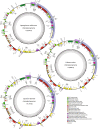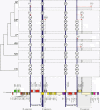Complete plastid genomes from Ophioglossum californicum, Psilotum nudum, and Equisetum hyemale reveal an ancestral land plant genome structure and resolve the position of Equisetales among monilophytes
- PMID: 23311954
- PMCID: PMC3553075
- DOI: 10.1186/1471-2148-13-8
Complete plastid genomes from Ophioglossum californicum, Psilotum nudum, and Equisetum hyemale reveal an ancestral land plant genome structure and resolve the position of Equisetales among monilophytes
Abstract
Background: Plastid genome structure and content is remarkably conserved in land plants. This widespread conservation has facilitated taxon-rich phylogenetic analyses that have resolved organismal relationships among many land plant groups. However, the relationships among major fern lineages, especially the placement of Equisetales, remain enigmatic.
Results: In order to understand the evolution of plastid genomes and to establish phylogenetic relationships among ferns, we sequenced the plastid genomes from three early diverging species: Equisetum hyemale (Equisetales), Ophioglossum californicum (Ophioglossales), and Psilotum nudum (Psilotales). A comparison of fern plastid genomes showed that some lineages have retained inverted repeat (IR) boundaries originating from the common ancestor of land plants, while other lineages have experienced multiple IR changes including expansions and inversions. Genome content has remained stable throughout ferns, except for a few lineage-specific losses of genes and introns. Notably, the losses of the rps16 gene and the rps12i346 intron are shared among Psilotales, Ophioglossales, and Equisetales, while the gain of a mitochondrial atp1 intron is shared between Marattiales and Polypodiopsida. These genomic structural changes support the placement of Equisetales as sister to Ophioglossales + Psilotales and Marattiales as sister to Polypodiopsida. This result is augmented by some molecular phylogenetic analyses that recover the same relationships, whereas others suggest a relationship between Equisetales and Polypodiopsida.
Conclusions: Although molecular analyses were inconsistent with respect to the position of Marattiales and Equisetales, several genomic structural changes have for the first time provided a clear placement of these lineages within the ferns. These results further demonstrate the power of using rare genomic structural changes in cases where molecular data fail to provide strong phylogenetic resolution.
Figures






Similar articles
-
Horsetails are the sister group to all other monilophytes and Marattiales are sister to leptosporangiate ferns.Mol Phylogenet Evol. 2015 Sep;90:140-9. doi: 10.1016/j.ympev.2015.05.008. Epub 2015 May 18. Mol Phylogenet Evol. 2015. PMID: 25999055
-
Complete plastome sequences of Equisetum arvense and Isoetes flaccida: implications for phylogeny and plastid genome evolution of early land plant lineages.BMC Evol Biol. 2010 Oct 23;10:321. doi: 10.1186/1471-2148-10-321. BMC Evol Biol. 2010. PMID: 20969798 Free PMC article.
-
Complete mitochondrial genomes from the ferns Ophioglossum californicum and Psilotum nudum are highly repetitive with the largest organellar introns.New Phytol. 2017 Jan;213(1):391-403. doi: 10.1111/nph.14135. Epub 2016 Aug 19. New Phytol. 2017. PMID: 27539928
-
Trends and concepts in fern classification.Ann Bot. 2014 Mar;113(4):571-94. doi: 10.1093/aob/mct299. Epub 2014 Feb 13. Ann Bot. 2014. PMID: 24532607 Free PMC article. Review.
-
Azolla--a model organism for plant genomic studies.Genomics Proteomics Bioinformatics. 2003 Feb;1(1):15-25. doi: 10.1016/s1672-0229(03)01004-0. Genomics Proteomics Bioinformatics. 2003. PMID: 15626330 Free PMC article. Review.
Cited by
-
Comparative and Phylogenetic Analysis Based on the Chloroplast Genome of Coleanthus subtilis (Tratt.) Seidel, a Protected Rare Species of Monotypic Genus.Front Plant Sci. 2022 Feb 24;13:828467. doi: 10.3389/fpls.2022.828467. eCollection 2022. Front Plant Sci. 2022. PMID: 35283921 Free PMC article.
-
Six newly sequenced chloroplast genomes from prasinophyte green algae provide insights into the relationships among prasinophyte lineages and the diversity of streamlined genome architecture in picoplanktonic species.BMC Genomics. 2014 Oct 4;15(1):857. doi: 10.1186/1471-2164-15-857. BMC Genomics. 2014. PMID: 25281016 Free PMC article.
-
From algae to angiosperms-inferring the phylogeny of green plants (Viridiplantae) from 360 plastid genomes.BMC Evol Biol. 2014 Feb 17;14:23. doi: 10.1186/1471-2148-14-23. BMC Evol Biol. 2014. PMID: 24533922 Free PMC article.
-
accD nuclear transfer of Platycodon grandiflorum and the plastid of early Campanulaceae.BMC Genomics. 2017 Aug 11;18(1):607. doi: 10.1186/s12864-017-4014-x. BMC Genomics. 2017. PMID: 28800729 Free PMC article.
-
Plastid Genomes of the Early Vascular Plant Genus Selaginella Have Unusual Direct Repeat Structures and Drastically Reduced Gene Numbers.Int J Mol Sci. 2021 Jan 11;22(2):641. doi: 10.3390/ijms22020641. Int J Mol Sci. 2021. PMID: 33440692 Free PMC article.
References
-
- Jansen RK, Ruhlman TA. In: Genomics of Chloroplasts and Mitochondria. 35. Bock R, Knoop V, editor. Netherlands: Springer; 2012. Plastid genomes of seed plants; pp. 103–126.
-
- Wolf PG, Karol KG. In: Genomics of Chloroplasts and Mitochondria. 35. Bock R, Knoop V, editor. Springer Netherlands: Springer; 2012. Plastomes of bryophytes, lycophytes and ferns; pp. 89–102.
-
- Wickett NJ, Zhang Y, Hansen SK, Roper JM, Kuehl JV, Plock SA, Wolf PG, DePamphilis CW, Boore JL, Goffinet B. Functional gene losses occur with minimal size reduction in the plastid genome of the parasitic liverwort Aneura mirabilis. Mol Biol Evol. 2008;25:393–401. doi: 10.1093/molbev/msm267. - DOI - PubMed
Publication types
MeSH terms
Substances
LinkOut - more resources
Full Text Sources
Other Literature Sources
Molecular Biology Databases

